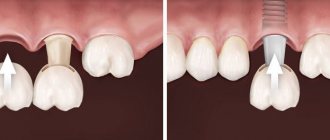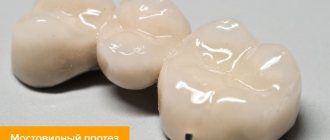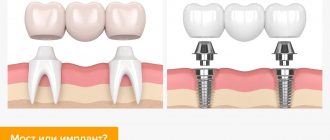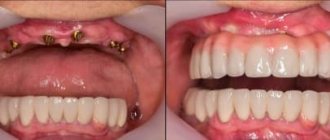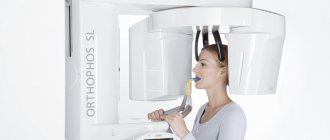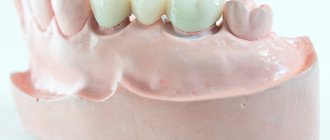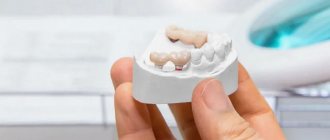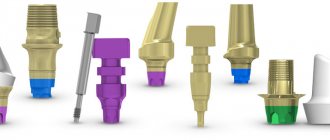A bridge on implants is a reasonable option for prosthetics in case of loss from 3 teeth to their complete absence. Cheaper than implantation of each lost tooth, more reliable than bridge prosthetics on your own teeth.
In our Center they are installed after computer diagnostics and bite examination, and are manufactured in our own dental laboratory. A lifetime warranty is provided for implants in our Center, and 25 years for metal-free crowns as part of a bridge.
A dental bridge on implants is a non-removable orthopedic structure made from welded crowns to restore several teeth in a row.
- Difference from traditional bridges The bridge is supported not by your own teeth, but by pre-installed implants. There is no need to grind down the enamel of adjacent healthy teeth.
- Difference from classical implantation Each tooth does not require a separate implant; fewer are installed. And the bridge includes crowns for each tooth. Allows you to save money.
Bridge prosthesis on implants
Advantages
If you lose several teeth in a row, dental bridges on implants are the right solution. Allows you to correctly distribute the load and not use healthy teeth.
- Neighboring teeth do not deteriorate. The supports are implants implanted into the jaw, and not your own teeth, which must be ground down.
- Durability Implants last a lifetime, and the service life of the prosthesis is at least twice as long as that of classic bridges.
- Aesthetics Crowns are no different from your own teeth. The aesthetic gingival contour is recreated.
- Affordability Savings compared to classic implantation, when each tooth is replaced with an implant and a crown.
Features of the technology
The method involves using only 3 pieces. dental implants from Nobel. They are used to support a complete mandibular denture. The implants are installed in the frontal group and are connected by a very strong titanium beam, which follows the curve of the lower jaw, thereby securely fixing the implants and evenly distributing the load between them.
Thus, the system consists of the following components:
- Trefoil implants: two-piece conical implants that have a smooth neck to shape the gum level and reduce the risk of peri-implantitis,
- milled titanium Trefoil beam, which is pre-fabricated on high-precision equipment in the Nobel Procera laboratory. For its manufacture, pure titanium without impurities is used, which eliminates the development of allergic reactions,
- Trefoil fixation mechanism: it consists of a screw, several washers and a ball abutment.
A special feature of the entire system is that the unique movable fastening system allows you to compensate for the deviation of the axis and position of the implants even with a slight tilt. In this way, the doctor is able to solve even the most complex clinical situations.
Is it always possible to put a bridge on implants?
A bridge prosthesis on implants is suitable in any clinical situation, regardless of the extent and location of the defect in the jaw
Installed when:
- loss of three adjacent teeth in a row; with fewer teeth there is no need
- absence of outer teeth in a row , when there is no support on one side for a conventional bridge
- complete edentia , when there are absolutely no supports for fixation for a traditional bridge
Bridges on implants do not require grinding of adjacent teeth.
They are used even in cases of terminal defects and complete edentia, which cannot be achieved with traditional bridge prosthetics. Another undoubted advantage is that there is no need to prepare the enamel of neighboring teeth, which means they will remain healthy and last longer.
Levin Dmitry Valerievich Chief physician and founder of the Doctor Levin center
How many implants are needed for partially missing teeth?
When calculating the number of implants, we take into account the distribution of chewing load
The load on the jaw when chewing should be uniform so that there is no subsidence of the gums and bone tissue under the hinged crowns. This will ensure the durability of the prosthesis and maintain aesthetics. Therefore, fixing a bridge on 2 implants is not always the right solution. It is recommended to use a 1:2 calculation - one implant for 2 crowns . Accordingly, the more teeth are missing, the more implants will be needed.
1-2 teeth missing
In this situation, bridges supported by implants are not relevant; teeth are restored separately. Each one has its own implant, which is covered with a separate crown. In this case, it is not recommended to combine crowns - if one is damaged, you will have to remove two at once. No 3 teeth
The most common clinical picture.
If there are no three adjacent teeth in a row, 2 implants are implanted along the edges of the defect, and a prosthesis for 3 teeth in the form of interconnected crowns is fixed on them. The outer ones are mounted on supports, and the middle one is hinged. You can install three implants, but this solution is cheaper. 4 missing teeth
When installing a bridge on 4 missing teeth in a row, the number of supports increases to three, and the number of crowns increases to four.
If you use two supports, then there will also be two mounted crowns. Atrophy of the jaw bone under the prosthesis cannot be ruled out due to uneven load. And the risk of prosthesis breakage increases due to increased pressure on the central part. No 5 teeth
Bridge prosthetics on implants is possible for 5 teeth or more. If five teeth are missing, three implants are needed. If a bridge of 6 teeth or more is required, three supports are used - the number is calculated by the number of crowns in the structure. The degree of future load and its distribution on the bone tissue are taken into account to prevent atrophy.
Full bridges for the lower and upper jaw
In case of complete edentia, fixed bridge structures are reinforced with a metal arch
The arch unites the crowns, increases the strength of the bridge and allows it to withstand severe chewing loads. The number of implants is determined depending on the clinical picture, anatomical features and jaw size.
- In the upper jaw, bone tissue has a lower density, therefore, during implantation, a larger number of implants are used - 8 pieces.
- On the bottom , on the contrary, the bone is denser, so 6 implants are enough for complete prosthetics. This is subject to standard jaw sizes. If the patient has a large jaw, two more implants are added to evenly distribute the load and ensure safe operation of the prosthesis.
A dental bridge with 6 implants is usually solid, but a denture with 8 implants can be made segmented - from four sections. This is a more convenient option - if necessary, you can remove only one segment, and not the entire prosthesis.
Also, in case of complete absence of teeth, the All-on-4 and All-on-6 protocols are used. 4 or 6 implants are installed on one jaw in a certain way, observing the principles of load distribution. Immediately on the day of implantation, a temporary non-removable adaptive prosthesis is installed, and after 6 months it is replaced with a permanent one.
Structure care
Care for a bridge on implants is the same as for living teeth. Regular cleaning is required - twice a day. In addition to a regular toothbrush, it is recommended to use special brushes to remove food debris from under the denture, floss and irrigator. It is advisable to start cleaning from the inside of the teeth and finish from the outside. After eating you need to rinse your mouth. Every six months you should visit the dentist for a preventive examination.
If you are missing one tooth or several, and even if there is not a single tooth left in your mouth, come to Uni Dent dentistry. Our specialists will “build” a high-quality bridge between the remaining molars, which will allow you to restore a “complete set of teeth” and acquire a confident smile, and, therefore, get rid of psychological discomfort. In addition, you will be able to chew any food efficiently, enjoying its taste.
What materials are they made of?
Dentures are manufactured in the Center’s own dental laboratory, you can choose the appropriate option to suit your taste and budget
- Metal-ceramic The base of the crowns is a metal alloy, the top is covered with ceramic mass. Relatively inexpensive, yet durable and quite aesthetic. The main disadvantage of metal ceramics is the ability to oxidize and cause a bluish outline to appear on the gums over time. Service life - 15 years or more .
- Zirconium Can be all-zirconium or coated with ceramics. They can withstand any load, do not deform, and retain their original appearance. Identical to natural teeth, the shade is selected individually. More expensive than metal-ceramic ones, but last longer. Service life - 25 years or more.
We offer patients the most profitable and practical methods, so we reserve the advantage for metal-free structures. In our Center, dental bridges are created in our own digital production using Zirkonzahn Schule technology or at the PROCERA (Nobel Biocare) plant in Sweden.
History of the All-on-3 protocol
All-on-3 or Trefoil is not a new technology. It appeared more than 15 years ago under the name “Branemark Novum”. The difference between the current technology and its predecessor is, in fact, only in one thing - then the implants had to be installed strictly vertically, and the implant surgeon had no right to even a slight error - deviations from the norm led to breakage of the screws and loosening of the entire structure.
As a result, it was decided to abandon the technology. But throughout this time, Nobel carried out its refinement and numerous studies. As a result, a beam was created with a special fixation mechanism, which made it possible to slightly change the angle of inclination of the implants without damaging the entire system. Without losing the strength of the entire system.
The Trefoil system in an updated version was introduced in 2015, but began to be used in Russia only in 2022.
Stages of installing a bridge on implants
The process includes several stages - diagnostic, surgical and orthopedic
Diagnostics and planning
Computer diagnostics are carried out, the data is necessary to assess the quality of bone tissue, and is used for virtual planning of the operation. In case of extended defects and complete absence of teeth, a bite examination is performed on an articulator so that after prosthetics the correct closure of the jaws is maintained. The treatment plan is drawn up by the orthopedist - he is the one who coordinates the work of the implantologist, determines the positioning points and the number of implants, taking into account future loads.
Implantation
During the operation, a calculated number of implants are implanted into the jaw. When bone tissue atrophies, osteoplasty is performed - bone tissue augmentation. This is necessary to create reliable fixation of the implants. We work only with premium Nobel Biocare systems and use original prosthetics . For anxious patients with cardiac problems, the possibility of surgery in medicated sleep is provided.
Temporary prosthetics
It will not be possible to install a permanent prosthesis immediately after implantation - you cannot create a strong load so as not to disturb the position of the implants. But you will never leave our Center without an orthopedic solution. On the same day, we will manufacture and install a temporary bridge from lightweight materials, which will hide the defect and last 2-4 or 6 months while the implants take root.
Permanent prosthetics
Permanent bridges are made after fittings and prototyping, taking into account the bite. Installed using transocclusal (screw) fixation. Unlike cement fixation, which is practiced in some clinics, the bridge, if necessary, can be removed without damaging the abutments (the connecting link between the implant and the prosthesis).
Bridge on implants or your own teeth - comparison
Each type of prosthetics has its own indications, advantages and disadvantages.
| Tooth-supported bridges | Implant-supported bridges |
| Prosthetic options Up to 3-4 teeth, not suitable for end defects | Prosthetic options From 3 teeth in a row to complete absence |
| Grinding of adjacent teeth is required | Grinding of adjacent teeth Not required |
| Reliability of fastening Possible tooth mobility due to periodontal diseases and inflammation | Reliability of fastening Complete stability due to the fusion of implants with the jaw bone tissue |
| Probability of bone atrophy High - the bone in the area of the defect dissolves and decreases without load | Probability of bone atrophy Low - the load on the bone is uniform due to the installation of the required number of implants |
| Service life Up to 7 years, depending on the condition of the supporting teeth | Service life of a prosthesis - from 15 years, implants - a lifetime |
| Price Lower - costs only for prosthetics | Price Higher - the cost of implantation is added |
In all respects, bridges on implants are superior , the only drawback is the cost in financial and time terms. First, implantation is performed, which requires additional costs and time.
A permanent bridge can be installed only after the implants have healed in order to avoid their displacement during chewing. But this does not mean that you will be left without teeth during this period. Immediately after the operation, we will make a temporary prosthesis that will last until the permanent one is installed and will hide the work performed. You will never leave our Center without teeth!
Disadvantages of the method
The technology also has some disadvantages:
- the need to introduce pins (foreign bodies), which frightens many people. But don't worry. Modern techniques allow you to perform any manipulation without causing discomfort and with minimal risk;
- possibility of thinning of bone tissue. But when using implants, atrophy will occur much more slowly than when using a removable denture;
- higher cost in relation to bridges, which are supported by living teeth. But it is worth considering that in this case it will be possible to avoid the preparation of dental units, which will prolong their service.
Service life of bridges on implants
Implant-supported bridges have increased stability compared to bridges supported on your own teeth. The period of operation does not depend on the condition of the supporting teeth, which over time can become loose from increased loads.
Implants create a uniform load on the bone tissue, eliminating subsidence of the bone under the prosthesis, thereby extending the service life of the structure. Metal-ceramic dentures last from 10 years, zirconium – from 25 years.
a 25-year guarantee on metal-free crowns supported by implants . The Center's warranty on the implants themselves . We use only premium Nobel Biocare implant systems and original prosthetics.
A little about bridges
Popularly, bridges are called the short word “bridge”. They received this name in dentistry due to the peculiarities of fixation. This type of dentures is represented by crowns, which are held on adjacent “supporting” teeth and replace the functions of their missing “brothers”. Thanks to the paired supporting fastening system, such a prosthesis is called a bridge.
A bridge is a one-piece structure that replaces one or two missing teeth in a row and is installed on the supporting teeth.
Modern bridge-like devices have a frame made of medical or precious alloys, which are coated with a ceramic composition. Various metal-free materials, metal-ceramics, zirconium dioxide or dental plastics can also be used.
You should be wary of your dentist's proposal to install a bridge if you have a large number of missing teeth. This can overload the jaws, involve too many supporting teeth and lead to the fragility of these structures.
What does the cost consist of?
Our Center provides a case payment system
The implant installation case includes:
- local anesthesia;
- cost of the Nobel Biocare implant and its installation;
- consumables and superstructures;
- applying and removing sutures;
- control CT diagnostics after surgery.
The case for installing a bridge includes:
- taking impressions;
- production of prosthesis;
- fitting and fixation of the structure.
Paid separately:
- Diagnostic case before implantation - the cost depends on the necessary studies.
- Osteoplastic surgery if necessary - the price is calculated depending on the type of bone augmentation and the duration of the defect.
- Sedation - calculated for each hour spent in medicated sleep. Usually 1 hour is enough to install 2-3 implants.
The total cost of bridge prosthetics on implants is formed taking into account:
- length of the defect;
- type and number of implants;
- number of crowns in the structure;
- the need for osteoplasty;
- use of sedation.
